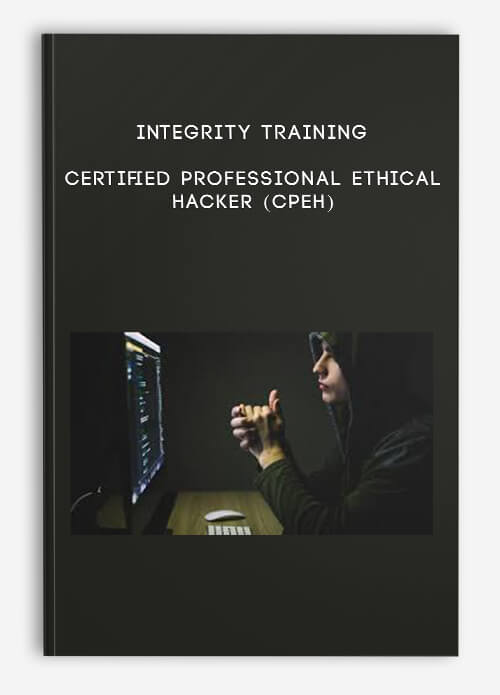Integrity Training – Certified Professional Ethical Hacker (CPEH)
$299.00 $72.00
Product Include:
File size:
Integrity Training – Certified Professional Ethical Hacker (CPEH)
**More information:
Get Integrity Training – Certified Professional Ethical Hacker (CPEH) at Salaedu.com
Description
This is the updated version (Updated Aug 2020)
- ACCREDITED by the NSA CNSS 4011-4016
- MAPPED to NIST / Homeland Security NICCS’s Cyber Security Workforce Framework
- APPROVED on the FBI Cyber Security Certification Requirement list (Tier 1-3)
Prerequisites:
- 12 months of IT security experience
- 12 months of Networking Experience
Student Materials:
Student Workbook
Student Prep Guide
Certification Exams:
Mile2 C)PEH – Professional Ethical Hacker
CPEs: 40
Who Should Attend?
- IS Security Officers
- IS Managers
- Risk Managers
- Auditors
- Information Systems Owners
- IS Control Assessors
- System Managers
Course Curriculum
Course Introduction
StartInstructor Introduction (2:38)
StartCourse Overview (1:50)
StartCourse Prerequisites (1:54)
StartDownload Resources
Module 1 – Introduction to Ethical Hacking
StartIntroduction to Ethical Hacking (0:11)
StartWhere are We? (0:12)
StartOverview (0:12)
Module 1 – Section 1: What and Why
StartWhat is Ethical Hacking? (0:48)
StartWhat is Ethical Hacking? Cont… (0:39)
StartWhy Ethical Hacking? (0:20)
StartDownfalls (0:28)
Module 1 – Section 2: Differences
StartItems we Cover (0:24)
StartWhat is a Penetration Test? (0:42)
StartWhite Hat/Red Team (1:16)
StartRed Team/Security Researcher (1:17)
StartDifferences (0:19)
StartTask Differences (0:14)
StartHacker vs. Ethical Hacker (0:33)
Module 1 – Section 3: Security Definitions
StartTypes of Hackers (1:15)
StartCIA Triad in Detail (0:47)
StartSecurity Definitions (1:18)
StartExploit and Vulnerability Lifecycle (1:03)
StartZero Day Anyone? (0:39)
StartRisk Assessment (1:13)
StartMile2 Glossary of Terms (0:20)
Module 1 – Section 4: Risk Management
StartRisk Management Flow (1:18)
StartWhat is the Value of an Asset? (1:07)
StartRisk Based Definitions (0:41)
StartWhat is a Threat Source/Agent? (0:54)
StartWhat is a Threat? (0:44)
StartWhat is a Vulnerability? (0:28)
StartExamples of Some Vulnerabilities that Are Not Always Obvious (1:04)
StartWhat is a Control? (0:35)
StartWhat is the Likelihood? (1:01)
StartWhat is the Impact? (0:38)
StartControl Effectiveness (1:02)
StartRisk Management (1:17)
StartReference Documents (2:12)
StartNIST SP 800-39 Risk Context (0:19)
StartPurpose of Risk Management (1:00)
Module 1 – Section 5: Methodologies
StartOptions (0:25)
StartEthical Hacking Methodologies (0:51)
StartPenetration Testing Methodologies (0:46)
StartOSSTMM (1:29)
StartOSSTMM – The Trifecta (0:29)
StartOSSTMM Combining Trifecta and 4PP (1:10)
StartNIST SP-800-115 (1:01)
StartNIST SP-800-115 Cont… (1:36)
StartISSAF Four Phases (0:26)
StartISSAF Diagram (1:14)
StartPTES (0:54)
StartMethodology for Penetration Testing (3:39)
StartSo Which One? (0:50)
StartNot Just Tools (0:16)
StartModule 1 Review (0:05)
StartModule 1 – Quiz
Module 2 – Linux Fundamentals
StartLinux Fundamentals (0:40)
StartWhere are We? (0:18)
StartOverview (0:30)
Module 2 – Section 1: Core Concepts
StartWhat is Linux? (1:20)
StartLinus + Minix = Linux (0:30)
StartGNU (0:34)
StartLinux GUI Desktops (0:33)
StartTop 10 Latest GUI Releases (0:39)
StartDistributions (1:12)
StartResources (0:37)
Module 2 – Section 2: The Shell and other items you need to know
StartShell (0:35)
StartLinux Shell (2:32)
StartLinux Bash Shell (0:37)
StartFile System Structure (0:51)
StartFile System Structure Cont… (1:46)
StartFile System Structure Cont… (2:42)
StartMounting Drives with Linux (0:43)
StartTarballs and Zips (1:33)
StartCompiling Programs in Linux (1:14)
StartIptables (1:03)
StartIptables (1:06)
StartIP Forwarding (0:45)
Module 2 – Section 3: Managing Users
StartAccounts and Groups (0:46)
StartPassword & Shadow File Formats (0:38)
StartPassword & Shadow File Formats Cont… (0:26)
StartAccounts and Groups (0:32)
StartUser Account Management (0:54)
StartChanging a User Account Password (0:25)
StartRoot Account (0:46)
StartLinux and Unix Permissions (0:39)
StartLinux and Unix Permissions Cont… (1:32)
StartLinux and Unix Permissions Cont… (0:34)
StartLinux and Unix Permissions Cont… (1:35)
Module 2 – Section 4: Basic Commands
StartNetwork Config (1:02)
StartWhere is my C: Drive? (0:55)
StartMounting CD (0:32)
StartManage Directories and Files (1:39)
StartModule 2 Review (0:35)
StartModule 2 – Quiz
Module 3 – Protocols
StartProtocols (0:59)
StartWhere are We? (0:11)
StartOverview (0:12)
Module 3 – Section 1: Network Models
StartNetwork Models (1:13)
StartOSI Model (1:21)
StartLayer 7: Application (1:23)
StartLayer 6: Presentation (0:52)
StartLayer 5: Session (1:24)
StartLayer 4: Transport (2:12)
StartLayer 3: Network (1:53)
StartLayer 2: Data Link (1:23)
StartLayer 1: Physical (1:31)
StartTCP/IP (1:01)
StartLayer 4: Application Layer (0:41)
StartLayer 3: Transport Layer (0:35)
StartLayer 2: Internet Layer (0:36)
StartLayer 1: Network Interface Layer (0:48)
StartOSI/TCP IP (0:39)
Module 3 – Section 2: Protocols & Services
StartProtocols at Each OSI Model Layer (0:55)
StartPorts and Protocols (3:15)
StartTCP vs UDP (3:14)
StartTCP Packet Content (3:52)
StartUDP Packet Content (0:40)
StartThree Way Handshake (1:05)
StartTCP Flags (2:00)
StartARP (1:35)
StartARP Process (2:35)
StartICMP (2:17)
StartICMP Messages (1:57)
StartDNS (2:10)
StartDNS Insecurities (1:02)
StartSNMP (2:27)
StartSNMP Insecurities (0:50)
StartSMTP (1:27)
StartSMTP Insecurities (1:25)
StartLDAP (0:43)
StartLDAP Insecurities (0:55)
StartServices to Consider (0:53)
StartModule 3 Review (0:20)
StartModule 3 – Quiz
Module 4 – Cryptography
StartCryptography (0:58)
StartWhere are We? (0:26)
StartOverview (0:29)
Module 4 – Section 1: Understanding Cryptography
StartCryptographic Definitions (0:56)
StartCryptographic Definitions Cont… (1:15)
StartA Few More Definitions (0:21)
StartCryptography Usage (1:10)
StartTypes of Cryptographic Algorithms (0:46)
StartEncryption/Decryption Methods (2:20)
Module 4 – Section 2: Symmetric Encryption
StartSymmetric Cryptography – Use of Secret Keys (1:40)
StartSymmetric Encryption (0:40)
StartSymmetric Keys (1:03)
StartStream Cipher & Block Cipher (0:33)
StartSymmetric Cipher – Stream Cipher (0:47)
StartXOR Encryption Process (1:24)
StartStream Cipher Modes (1:05)
StartStrength of a Stream Cipher (1:26)
StartSymmetric Cipher – Block Cipher (0:24)
StartS-Boxes Used in Block Ciphers (0:47)
StartBlock Cipher Modes (0:17)
StartBlock Ciphers – ECB (0:28)
StartBlock Cipher – CBC (0:40)
StartCBC Mode (0:43)
StartBlock Cipher Modes – CFB and OFB (1:05)
StartCTR Mode (0:37)
StartSymmetric Algorithms – DES (0:36)
StartEvolution of 3DES (1:30)
StartSymmetric Cipher – AES (1:02)
StartOther Symmetric Algorithms (0:28)
Module 4 – Section 3: Asymmetric Encryption
StartAsymmetric Cryptography (2:14)
StartAsymmetric Encryption (0:17)
StartWhen to Use Which Key? (1:42)
StartAsymmetric (0:04)
StartKey Exchange (1:01)
StartDiffie-Hellman (0:31)
StartAsymmetric Algorithm – RSA (1:05)
StartAsymmetric Algorithms – El Gamal and ECC (0:41)
StartPublic Key Cryptography Advantages (1:12)
StartAsymmetric Algorithm Disadvantages (0:47)
StartSymmetric versus Asymmetric (0:33)
StartExample of Hybrid Cryptography (1:31)
StartDigital Signatures (0:35)
StartDigital Signature (0:34)
Module 4 – Section 4: Hashing
StartHashing Algorithms (1:22)
StartProtecting the Integrity of Data (1:21)
StartData Integrity Mechanisms (1:02)
StartSecurity Issues in Hashing (1:23)
StartSimple MAC (0:42)
StartWeakness in Using Only Hash Algorithms (0:20)
StartHMAC – Sender (0:25)
StartHMAC – Receiver (0:06)
StartQKD (0:56)
StartQKD Cont… (0:09)
Module 4 – Section 5: Cryptography in Use
StartLink versus End-to-End Encryption (0:53)
StartEnd-to-End Encryption (0:25)
StartSAs in Use (1:00)
StartEncrypted Message (0:20)
StartSecure E-mail Standard (0:39)
Module 4 – Section 6: Crypto Attacks
StartTheoretical Cryptanalysis (1:44)
StartTheoretical Cryptanalysis Cont… (1:08)
StartBirthday Attack (1:23)
StartExample of a Birthday Attack (1:25)
Module 5 – Password Cracking
StartWhere are We? (0:23)
StartOverview (0:12)
Module 5 – Section 1: What and Why
StartWhy it is kind of a no brainer! (0:35)
StartPassword Cracking Strategy Cont… (0:54)
StartPassword Cracking Strategy Cont… (1:37)
StartCracking Techniques (3:07)
Module 5 – Section 2: Attacks and Tools of the Trade
StartPassword Guessing (1:25)
StartPassword Cracking LM/NTLM Hashes (2:53)
StartSyskey Encryption (1:08)
StartRainbow Tables (2:09)
StartGPU and/or CPU for Password Cracking (2:04)
StartCain and Abel’s Cracking Methods (1:04)
StartRainbow Tables Limitations (1:06)
StartPassword Salting (1:11)
StartPassword Salting Cont… (0:47)
StartNTPASSWD: Hash Insertion Attack (1:54)
StartMimikatz (1:10)
StartA Few other Common Tools (0:52)
Module 5 – Section 3: Countermeasures
StartImplement General Password Policies that Work! (3:54)
StartConsider Something Better (1:51)
StartUnderstand the Windows Authentication Protocols (3:42)
StartSecurity Items to Consider (1:40)
StartSecurity Items to Consider Cont… (1:07)
StartModule 5 Review (0:10)
StartModule 5 – Quiz
Module 6 – Section 1: DOS & DDOS
StartDistributed Denial of Service Cont… (0:30)
StartDenial of Service Impact (1:12)
StartDoS Attack Symptoms (1:48)
StartDigital Attack Map: A Global Threat Visualization (0:53)
StartDoS Attack Methods (7:11)
StartBotnet Ecosystem (1:55)
StartBOTNET Tools (0:28)
StartDoS/DDoS Attack Tools (0:40)
StartHigh Orbit Ion Canon (HOIC) (0:38)
StartDoS Attack Detection (2:03)
StartDoS Detection Sequential Change Point Detection (0:28)
StartDoS Detection – Wavelet Analysis (1:09)
StartDoS/DDoS Countermeasures (3:12)
StartBotnet Countermeasures (2:21)
Module 6 – Section 2: Viruses and Worms
StartWhat they do (1:39)
StartTypes of Viruses (1:27)
StartTypes of Viruses Cont… (1:39)
StartHow do you get Infected? (3:16)
StartDNS Changer Virus (0:43)
StartMelissa Virus (1:01)
StartWorms (0:50)
StartStorm Worm (0:55)
StartStuxnet (0:58)
Startconficker (0:34)
Module 6 – Section 3: Trojans & Backdoors
StartRemote Access Trojan (RAT) Components (1:52)
StartMeet Zberb (0:30)
StartExecutable Wrappers (0:40)
StartAvoiding Detection (1:02)
StartREFUD (0:52)
StartMalware Countermeasures (1:34)
StartMalware Reference: www.BleepingComputer.com (0:27)
StartMonitoring Autostart Methods (1:00)
StartSigCheck (1:15)
StartHardware-based Malware Detectors (0:37)
StartUser Education (0:51)
Module 6 – Section 4: Ransomware
StartRansomware (0:59)
StartFamous Ransomware (1:19)
StartRansomware and Cryptocurrency (0:42)
Module 7 – Section 1: Basic Security Elements
StartIntroduction (1:10)
StartSwitching and Routing (3:12)
StartSwitch Security (4:37)
StartRouter Security (1:53)
StartRouter Security Cont… (4:19)
Module 7 – Section 2: Security Appliances
StartFirewall (1:32)
StartNext Generation Firewall (2:16)
StartDMZ (1:25)
StartIDS (1:25)
StartIDS Cont… (1:11)
StartIPS Cont… (1:10)
StartSIEM (1:06)
StartModule 7 Review (0:27)
StartModule 7 – Quiz
Module 8 – Information Gathering – Reconnaissance-Passive (External Only)
StartInformation Gathering – Reconnaissance-Passive (External Only) (1:07)
StartWhere are We? (0:34)
StartOverview (0:12)
Module 8 – Section 2: Where/How do we find this information?
StartWhere? (1:23)
StartWHOIS (2:44)
StartDNS Databases (2:16)
StartUsername Searches (0:59)
StarteMail Address Searches (1:06)
StartPeople Search Engines (3:06)
StartBusiness Search Engines (1:10)
StartWeb Server Info Tool: Netcraft (2:37)
StartBlogs & Forums (1:00)
StartGoogle Hacking (4:24)
Module 8 – Section 3: Are there tools to help?
StartMaltego – Clear Leader (0:47)
StartRecon-ng (0:55)
StartRecon-ng Cont… (0:25)
Starttheharvester (0:43)
StartFirecat/Kromcat (1:36)
StartModule 8 Review (0:26)
StartModule 8 – Quiz
Module 9 – Social Engineering
StartSocial Engineering (1:07)
StartWhere are We? (0:52)
StartOverview (0:15)
Module 9 – Section 1: Social Engineering Types
StartOrganization Vulnerabilities (1:21)
StartHuman Based Social Engineering (2:17)
StartHuman Based Social Engineering Cont… (5:24)
StartSocial Engineering Techniques (4:10)
StartSocial Engineering Gaps (2:55)
StartSocial Network Lookup http://namechk.com/ (0:29)
StartImpact of Social Engineering (0:55)
StartSocial Media Protection (2:03)
StartIdentity Theft and PII (1:04)
StartIdentity Theft and PII Protection Cont… (1:07)
Module 9 – Section 2: Phishing Scams
StartSpear Phishing (1:36)
StartRecent Successful Whaling Attacks (0:15)
StartWhaling Mitigation (1:29)
StartPhishing Protection (1:34)
StartModule 9 Review (0:20)
StartModule 9 – Quiz
Module 10 – Reconnaissance-Active Scanning-Enumeration
StartReconnaissance-Active Scanning-Enumeration (0:31)
StartWhere are We? (0:34)
StartOverview (0:30)
Module 10 – Section 1: What are we looking for?
StartWhat is it? (0:57)
StartWhat are we looking for? (0:56)
Module 10 – Section 2: Port Scanning
StartPort Scans Should Reveal… (1:11)
StartComparison of Models (1:25)
StartTypes of Scans (0:15)
StartTCP/IP Suite (1:13)
StartTCP Flags (0:18)
StartTCP 3-Way Handshake (0:57)
StartTCP Connect Port Scan (0:44)
StartHalf-open Scan (SynScan) (1:06)
StartFirewalled Ports (0:51)
StartUDP versus TCP (0:22)
StartUDP Port Scan (1:09)
Module 11 – Section 1: What is a Vulnerability Assessment?
StartWhat is a Vulnerability Assessment (VA)? (1:47)
StartBenefits of a Vulnerability Assessment (2:59)
Module 11 – Section 2: Tools of the Trade
StartChoosing the Right Tool (1:36)
StartThe List (1:50)
StartNetwork Based Tools Comparison (0:54)
StartApplication Based Tools Comparison (0:22)
Module 11 – Section 3: Testing Internal/External Systems
StartDetection (1:12)
StartAdditional Details (2:16)
StartEasily Exploitable Vulnerabilities (0:44)
Module 12 – Network Attacks
StartNetwork Attacks (0:20)
StartWhere are We? (0:39)
Module 12 – Section 1: Sniffing Techniques
StartPacket Sniffers (0:46)
StartExample Packet Sniffers (0:36)
StartTool: Pcap & WinPcap (0:34)
StartTool: Wireshark (0:45)
StartTCP Stream Re-assembling (0:42)
Starttcpdump & windump (0:50)
StartSniffer Detection using Cain & Abel (0:51)
StartPassive Sniffing (0:55)
StartActive Sniffing (1:34)
StartActive Sniffing Methods (2:43)
StartSwitch Table Flooding (0:46)
StartARP Cache Poisoning (1:38)
StartTechnique: ARP Cache Poisoning (Linux) (0:47)
StartDNS Poisoning (1:18)
StartTool: Cain and Abel (0:53)
StartEttercap (0:20)
StartLinux Tool Set: Dsniff Suite (0:59)
StartWhat is DNS Spoofing? (1:08)
StartTools: DNS Spoofing (0:58)
StartBreaking SSL Traffic (1:53)
StartCountermeasures Cont… (0:32)
StartCountermeasures for Sniffing (0:49)
Module 12 – Section 2: Hijacking
StartSession Hijacking (1:32)
StartSession Hijacking Cont… (1:29)
StartContributors to Session Hijacking (2:02)
StartImpact of Session Hijacking (1:10)
StartSession Hijacking Techniques (0:48)
StartStealing and Calculating Session IDs (0:51)
StartSession Hijacking Process (1:07)
StartTypes of Session Hijacking (1:31)
StartApplication-level Session Hijacking (1:08)
StartMan-in-the-Middle Attacks (0:45)
StartClient-side Attacks (0:58)
StartMan-in-the-Browser Attacks (1:02)
StartSession Sniffing (0:54)
StartTCP/IP Hijacking (1:11)
StartSession Hijacking Tools (1:04)
StartProtecting against Session Hijacking (2:01)
StartProtecting against Session Hijacking Cont… (0:59)
StartProtecting against Session Hijacking – Web Users (1:13)
StartModule 12 – Quiz
Module 13 – Hacking Servers
StartHacking Servers (1:07)
StartOverview (0:19)
Module 13 – Section 1: Servers, what are they good for?
StartServers, what are they good for? (1:10)
StartKnow the OS (4:38)
StartKnow How it is Used (3:43)
Module 13 – Section 2: What is an Exploit?
StartWhat is an Exploit? (1:49)
StartExploit Development (5:05)
StartExploit Development Cont… (1:00)
Module 13 – Section 3: Tools of the Trade
StartExploit-db (0:58)
StartSearch Exploit-db (0:28)
StartUnderstanding Metasploit (3:36)
StartHands on Metasploit (0:48)
StartCore Impact (0:59)
StartSaintExploit at a Glance (1:53)
Module 13 – Section 4: Testing Internal/External Systems
StartIt starts here! (1:16)
StartExternal Systems (1:29)
StartOutside of Possible Evasion Techniques (4:17)
StartInternal Systems (2:46)
StartInside out Possible Evasion Techniques (4:10)
StartClient-Side Attacks (1:50)
StartPhysical Access Attacks (2:12)
StartModule 13 Review (0:40)
StartModule 13 – Quiz
Module 14 – Assessing and Hacking Web Technologies
StartAssessing and Hacking Web Technologies (0:09)
StartWhere are We? (0:48)
StartOverview (0:21)
Module 14 – Section 1: OWASP Top 10
StartOWASP Top 10 (0:26)
StartA2 – Broken Authentication (2:50)
StartA3 – Sensitive Data Exposure (1:26)
StartA4 – XML External Entities (XXE) (1:34)
StartA6 – Security Misconfiguration (2:13)
StartA7 – Cross-Site Scripting (2:48)
StartA8 – Insecure Deserialization (1:50)
StartA9 – Using Components with Known Vulnerabilities (2:01)
StartA10 – Insufficient Logging and Monitoring (1:34)
Module 14 – Section 2: SQL Injection
StartIntroduction (0:31)
StartTypes of SQL Injection (0:15)
StartBlind SQL Injection (1:45)
StartSimple SQL Injection Attack (2:54)
StartUnion & Error Based SQL Injection (2:02)
StartSQL Injection Tools (3:04)
StartSQL Injection Tools Cont… (0:39)
StartSQL Injection Tools Cont… (0:28)
StartSQL Injection Detection Tool (0:41)
StartSQL Injection Detection Tool Cont… (0:17)
StartSQL Injection Detection Tool Cont… (0:30)
Module 14 – Section 3: XSS
StartIntroduction to Cross-Site Scripting (0:33)
StartType of XSS (0:35)
StartStored XSS or Persistent/Type I (1:16)
StartReflected XSS (Non-Persistent or Type II) (0:57)
StartServer XSS (0:42)
StartClient XSS (0:54)
StartXSS Types in the Matrix (0:33)
StartTest for XSS Vulnerability (0:17)
Module 15 – Section 1: Wireless Technologies
Start802.11 Wireless Background Information (0:40)
StartWireless LAN (WLAN) (0:37)
StartBasic Items SSID (Service Set Identity) (0:48)
StartBasic Items MAC Filtering (1:13)
StartEncryption Protocols (0:29)
StartWEP (1:37)
StartWEP Weak IV Packets (0:51)
StartWPA-PSK Encryption (1:05)
StartWireless Security 802.11i – WPA2 Cont… (0:52)
StartWPA and WPA2 Mode Types (0:35)
Start4-Way Handshake AES-CCMP – WPA2 (0:43)
StartWPA2 Weaknesses (0:56)
StartWPA3 Improvements Cont… (0:40)
StartWPA3 Improvements Cont… (0:58)
StartWi-Fi Protected Setup (1:03)
StartAuthentication (0:22)
StartOpen Authentication (0:53)
StartShared Key Authentication (0:59)
StartEAP Authentication (1:25)
StartMAC Address Authentication (0:47)
StartBluetooth (1:01)
StartBluetooth Protocol Stack (2:01)
StartThe Pairing Process (1:16)
StartBasics of Bluetooth Security (1:26)
StartBasics of Bluetooth Security Cont… (0:49)
StartBluetooth Security (1:05)
Forex Trading – Foreign Exchange Course
Want to learn about Forex?
Foreign exchange, or forex, is the conversion of one country’s currency into another.
In a free economy, a country’s currency is valued according to the laws of supply and demand.
In other words, a currency’s value can be pegged to another country’s currency, such as the U.S. dollar, or even to a basket of currencies.
A country’s currency value may also be set by the country’s government.
However, most countries float their currencies freely against those of other countries, which keeps them in constant fluctuation.
1 review for Integrity Training – Certified Professional Ethical Hacker (CPEH)
Add a review Cancel reply
Related products
Forex - Trading & Investment
Forex - Trading & Investment
Paul Lemal – Bottom Springers. Bonsai Elite WaveTrader Course (8 DVDs & Manuals)
Forex - Trading & Investment
Pristine – Paul Lange – Creating & Using a Trading Plan + Seven Steps to a Good Trade
Forex - Trading & Investment











king –
We encourage you to check Content Proof carefully before paying.“Excepted” these contents: “Online coaching, Software, Facebook group, Skype and Email support from Author.”If you have enough money and feel good. We encourage you to buy this product from the original Author to get full other “Excepted” contents from them.Thank you!